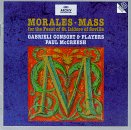| All Artists: Morales, Mccreesh, Gabrieli Consort Title: Mass for St. Isidore Members Wishing: 0 Total Copies: 0 Label: Polygram Records Release Date: 7/23/1996 Genres: Special Interest, Pop, Classical Styles: Vocal Pop, Opera & Classical Vocal, Historical Periods, Early Music, Renaissance (c.1450-1600), Instruments, Keyboard Number of Discs: 1 SwapaCD Credits: 1 UPC: 028944914320 |
Search - Morales, Mccreesh, Gabrieli Consort :: Mass for St. Isidore
 | Morales, Mccreesh, Gabrieli Consort Mass for St. Isidore Genres: Special Interest, Pop, Classical
This recording seeks to re-create the occasion of a Mass for the Feast of St. Isidore of Seville as it might have been celebrated in Toledo Cathedral around 1590. Although we know such undertakings involve a lot of guesswo... more » |
Larger Image |
CD DetailsSynopsis
Amazon.com essential recording This recording seeks to re-create the occasion of a Mass for the Feast of St. Isidore of Seville as it might have been celebrated in Toledo Cathedral around 1590. Although we know such undertakings involve a lot of guesswork, with performers like Paul McCreesh and his Gabrieli Consort, we know the effort is supported by conscientious research and intelligent speculation. We also are reassured by the well-written liner notes. And when we hear the opening instrumental "Cancion," we are happily drawn into the whole concept. This is a beautiful and brilliantly conceived program, featuring works by various 16th-century composers and centered around the outstanding Morales mass. The singing is superb, the instrumental playing unassailable. This is a top choice for every early music library. --David Vernier Similarly Requested CDs
|
CD ReviewsA very worthwhile recording hcf | 01/04/2000 (5 out of 5 stars) "As far as I know, there are two recordings of Morales' Missa Mille Regretz currently in the catalogue: this recording by McCreesh and a 1991 recording by the Hilliard. These two recordings, although interpreting the same mass, serve very different purposes. You may want to own both of them, or only one (well, I'm assuming you want AT LEAST one, otherwise you wouldn't be looking at this page, right?). If you're interested in this mass as an art piece, all you need is the Hilliard. However, if you're interested in the broader context, you must own [also or only] the McCreesh. In what has become his signature practice, McCreesh performs this mass as part of a church liturgy. The music is interpolated with chants and prayers (a nice touch, although, I must confess, after a few minutes these interporations get a bit tedios). The mass movements are supplemented with canzonas, the same way recordings of Venetian vespers frequently are (these canzonas, by Rogier, Guerrero & Cabezon, are performed on cornetts, shawns, recorders, dulcians and an organ). The 6-part mass, sung by a 12-person choirs, is itself accompanied by a dulcian (which, however, appears only intermittently). McCreesh presents only the 1545 (probably, the final) version of the mass. In contrast, the Hilliard sing both the entire 1545 version, and three movements from an earlier version surviving in the 1568 Wittenberg manuscript. I'm glad that the Wittenberg version had gotten the Hilliard's attention because, in my humble opinion, the Wittenberg Sanctus is actually the most beautiful part in the whole mass. Its echoing Osannas are mesmerizing. Unfortunately, the Sanctus on the McCreesh is the least successful part of the recording, with Osannas taken in a choppy, unduly fast manner. However, the intervening solo section between the choppy Osannas is very beautiful. Unlike the Gabrieli Consort, the Hilliard sing the whole mass solo, i.e., one voice per part. Their tempi are generally faster, but uniformly so, without the surprises such as McCreesh' Sanctus. The singers on both recordings are excellent, with one exception. Both recordings share Robert Jones, whose shrill falsetto marrs the otherwise gorgeous top line in both recordings. That is just too bad, because his line gets the most quotations from the famous chanson Milles Regretz. But don't let that dissuade you. In addition to the mass, McCreesh' recording also includes a beautiful motet Emendemus in melius which I'd never heard before. gkolomietz@yahoo.com" A choice recording... Guy Cutting | 06/16/2000 (5 out of 5 stars) "The centerpeice of this recording is, obviously, the Milla Regretz mass by Morales. Other composers are represented as well - music by Cabezon, Rogier, Guerrero, and Gombert is recorded. It is all of high quality, but the music by Guerrero and Morales really shines. Guerrero and Morales were both held in the highest regard during their lifetimes and immediately afterwards (Morales, in fact, was more highly regarded than any Spanish composer until Victoria). The music included here shows why. Both Morales and Guerrero are terribly underrepresented in the early music catalog - each has only recieved a handful of recordings. But fortunately this recording focuses on Morales (with several of Guerrero's compositions as well) and both show themselves to be worthy of more attention. The music (almost all of it at least) is most enjoyable. The canzons are really very beautiful, recorded as they are on cornetts, shawms, sackbutts, and dulcians. These instruments, which we don't get a lot of opporunity to hear, produce a really pleasant sound, especially in combination. A canzon is, from what I understand, a piece which begins with an exposition with the instruments in formal imitation, continues to a development section in which thematic fragments are employed, and then returns to a section of restatement of the original subject. They are fascinating pieces which are dominated by polyphony and the sound of these instruments in interplay with one another is really grand. The organ intonations on the recording are also very colorful and provide a great deal of variety to the service. The chant is well done, for the most part (I'll get to this later) and in the form of scriptural lessons and prayers are most relaxing and again are an important facet to this program. Two motets are included, one by Guerrero and one by Morales, occuring at key moments in the service. Both are very beautiful, marked by flowing polyphony. Finally the Mass itself employs a variety of styles - from smooth imitative polyphony to declamation to very delicate reduced-part sections. I have always enjoyed music in the Spanish tradition which is always most profound - the famous Spanish darkness is here in some quantity, but there is also a great degree of other emotions as well. Beyond just the quality of the music, it is important to remember the overall unity which McCreesh is going for (and which he succeeds in admirably). The Gabrieli Consort always seeks to present music in its original context and that approach makes for a very powerful listening experience. Recordings of masses without the same treatment are always in danger of focusing solely on the music as an art form, sacrificing attention to the religious nature of the piece (not that all of them do, of course). Presentation of the mass in its context, though, serves to keep that religious context always at the forefront (and the effect achieved is very compelling - even listeners, though, who bring no religious background to the listening can still benefit from the tremendous reflective and contemplative quality of the music). McCreesh seems to have a sense of architecture, almost - he creates a unified whole in which each piece serves a role. Variety is important to color and mood (and I think makes for a better experience), but doesn't mean much if it comes at the expense of artistic integrity. McCreesh infuses the program with a great deal of variety, but as I said also a great deal of unity.The most immediately noticable thing, to me, about the recording was the wonderful acoustic richness - there is a lot of reverberation in the Brinkburn Priory and I think that it makes for a really nice mood. The quality of the instrumental playing is quite good - it is clean and pure. The singing is good as well (it's not perfect). My complaint about the texture of the sound is that it's rough or coarse (if that makes any sense) - the sound is not nearly as smooth and sweet as Chanticleer, if you're familiar with them; the "roughness" is especially apparent in the chant - it's a little jarring to me. I guess it's not that much of a problem, though (it's dependent on taste). Where the sound does succeed though is in its density and color. This all male group produces a very pleasing dark, thick (which I think can be virtues) sound (which is partly a biproduct of six voice scoring and doubling of the bass part by a dulcian). I very much like the practice of instrumental doubling - it adds an extra dimension to the music. The group sings with excellent pitch, but the balance is not always great (some of the middle parts tend to disappear), but it seems that the focus for McCreesh is on overall texture, so maybe it's partly intentional. The falsettists are fabulous. Interpretive decisions are generally good - McCreesh seems to have a good feel for the music. Some tempi are too fast (the Osannas in the Sanctus sound decidedly un-musical, but other than in that spot the problem is rare) but most are fine. But despite those minor problems the quality of the music is generally very high. Even more important, though, is unique value of the music and its presentation. McCreesh presents some music which is not recorded elsewhere (Morales' mass is available on a recording by the Hilliard Ensemble, but I haven' heard that recording so I can't compare the two) such as the Guerrero motet and canzons, and he does so in a context which gives this gorgeous music what it deserves.You really won't be disappointed with this disc. Recommended..."
|

 Track Listings (27) - Disc #1
Track Listings (27) - Disc #1







